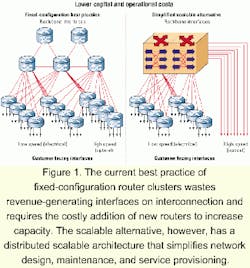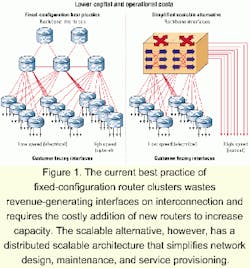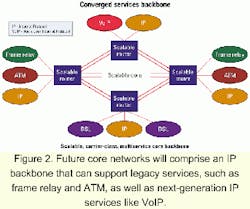New demands drive shift in the carrier core
Moving from fixed to scalable core routing architectures to achieve lower cost, higher profit, and improved service velocity.
ESMERALDA SWARTZ, Avici Systems Inc.
There are many reasons service providers are migrating their fixed-configuration core-router network to one based on a next-generation scalable router architecture. First, there are some underlying market fundamentals that have made that necessary. We've all heard the statistics. Internet traffic is growing at a staggering rate, with the latest projections from market-research firms like San Francisco-based RHK Corp. RHK estimates traffic will reach some 150 million Tbytes per month by 2003, up from 350,000 Tbytes per month in 1999.
Industry pundits and carriers estimate Internet Protocol (IP) traffic is doubling every three to four months and will represent 90% of network traffic by 2003. Regardless of which prediction you choose to believe, the fact is it's hard for carriers to know what their bandwidth requirements will be in six months-never mind in two years.
The dilemma faced by carriers is multifaceted. How to:
- Accommodate the unpredictable nature of the Internet.
- Increase the capacity of network links to carry data traffic.
- Provision new services quickly to increase profitability.
- Minimize the operational and capital costs (operational being more of a concern) of running the network to support these new requirements.
The most significant roadblock is that using multiple routers and/or displacing a core router with the next bigger box every 12 months causes disruption to the network and, more important, disrupts service to customers. Here is an example of what carriers should consider when looking at their bandwidth-capacity requirements:
A large carrier requires 30 OC-48 (2.5-Gbit/sec) ports, which translates to 75 Gbits/sec (30x2.5 Gbits/sec) of throughput. The carrier wants to split the throughput between two routers, each with 15 OC-48s and 37.5 Gbits/sec of line throughput. In order to support this requirement with a fixed-configuration system, the carrier has to buy three nearly full routers and 42 interfaces to obtain an effective capacity of 30.
Increasing routing capacity using fixed-configuration routers requires that a carrier increase the equipment footprint and deal with the operational and capital outlays in IP experts to install and configure the new routers, the service disruption to customers, and the capital outlay to purchase multiple routers.
The mismatch between current-generation router performance and the demand for increased capacity to support IP traffic is widening. Furthermore, for carriers to begin to take advantage of optical capacity on the transport network, they must have a scalable router architecture that has been designed to grow along with the transport network. It is simply not practical for carriers to install a new router every time they run out of capacity or upgrade to higher-speed line cards.
Unlike fixed-configuration offerings, new scalable routers do not require system changes every time new capacity or new line cards, such as OC-192c (10 Gbits/sec), are needed. A truly scalable router design does not require changes to system chassis; instead, it provides superior investment protection and true plug-and-play support.
The reality is that current fixed-configuration routers have become ill-suited for the growing needs of large service-provider network cores. Increasingly, such older routers are either being pushed to the edge of large networks or used only by smaller providers. As a matter of economics and network operations, carriers are seeking equipment footprints that can scale along with requirements while the network remains in service. Competitively, they can no longer afford to be constrained by the underlying network topology.
Carriers using fixed-configuration routers are always on a treadmill of forklift upgrades that never seems to stop. That is no longer a viable business model. Carriers are under extensive competitive pressure to grow their network to support more profitable IP services and at the same time squeeze margin out of their existing legacy network.
To do that, they are deploying scalable routers to futureproof their network, grow bandwidth on demand, and reduce provisioning times for new services. It was only a matter of time before carriers began to adopt a nondisruptive and incremental method of scaling their networks, since that allows them to run the network according to business requirements and not the limitations of their infrastructure. Provisioning bandwidth on demand, however, is only one aspect of the overall equation.
Most industry observers agree that future traffic growth will be primarily IP-based and future core networks therefore will be composed of an IP-based infrastructure that supports legacy and next-generation IP services. Figure 2 shows a typical converged service backbone. Significant progress has been made in delivering quality-of-service (QoS) to IP and the Internet to support mission-critical or real-time applications such as video on demand, voice over IP (VoIP), and virtual private networks (VPNs).Traffic engineering technologies such as Multiprotocol Label Switching (MPLS), IP precedence, and differentiated services (DiffServ) are now available from a growing number of vendors, enabling carriers to differentiate various types of traffic and guarantee the performance of certain applications. Further more, carriers have options available to them when building an MPLS network. Interoperability testing of MPLS implementations by leading router vendors is enabling carriers to build a best-of-breed QoS network using products from different suppliers.
Another key differentiator of next-generation routers will be their ability to perform at wire rate regardless of route prefix length, route table size, MPLS label swapping, QoS, or multicast. That will mean QoS needs to be hardware-based and buffers need to be dynamically configured to support both real-time delay-sensitive and non-real-time delay-insensitive applications. Service providers want to utilize advanced QoS features to offer enhanced service-level agreements for service differentiation.
The new core router incorporates a distributed architecture with backplane interconnects, allowing for continual in-service upgrades, so a carrier can easily grow from OC-48 to OC-192 or even OC-768 (40 Gbits/sec) in the same platform. The unquestionable dependability of such a system, combined with advanced QoS and MPLS capabilities, allows carriers to sell advanced revenue-generating services such as VPNs, VoIP, and video-on-demand, while supporting legacy services.
Network designers achieve multiple benefits from using inherently scalable technologies at the core of their network. These benefits provide tangible reductions in capital costs, together with increased operational efficiency and cost reductions. Network designers also gain significant network performance and reliability benefits, which become more apparent as the solution scales in size, since capacity is able to grow in a linear fashion.
In large, high-speed networks, where the rate of growth is high or likely to be high, the use of a scalable core router provides a highly compelling value proposition to the network operator-in summary, the ability to scale over time as one router offers many operational cost savings advantages.
The difficulty of making changes to route tables and sending scarce IP experts to reconfigure route tables is eliminated. Carriers need to maintain only a single route table, even when the router itself has grown to hundreds of interfaces and multiple routers worth of capacity.
Maintaining one scalable router with a single route table reduces the complexity of the network for upgrades, design, management, and operations. Requirements for power, cooling, maintenance, and sparing remain the same, in a scalable system, whereas these factors are all unknown in a multirouter architecture. Network engineers have to figure out if the next router upgrade will need a 27-inch rack, unique cooling requirements, or new cable management. The network design process can be made simpler with annual revisions, rather than constant time-consuming, ongoing planning and product evaluation process. This simplification stops the need for the day-to-day involvement of the architecture and lab groups.
Networks designed with scalable routers make it easier for network operators to perform system backup of configuration files and enact newer system-wide policies and cable management. Since equipment requirements are known, daily operations will be simple for operations staff. That will be particularly important as a point of presence (PoP) scales in size, because the router will always appear the same.
To enhance service offerings and remain competitive, service providers are constantly modifying their networks, leading to constant software upgrades. A scalable router allows simplified and dependable upgrades by using a secure and reliable software upgrade solution with fast fallback (dual servers, dual images). The multirouter fixed-configuration system is more complex due to node count and multiple hardware and software revisions that need to be supported.
Scalable routing platforms enable carriers to reduce the provisioning time of new service offerings for competitive differentiation and increased revenue streams. A carrier's success will be determined by how quickly they can beat their competitors to market with a new service offering and differentiate themselves from the pack. As bandwidth becomes a commodity and it ceases to be a growing source of revenue, carriers will have to provision new IP services and fill up fatter network pipes to maintain the bottom line.
The new 21st century network core will comprise routers specifically designed for carrier and Internet service-provider (ISP) backbones. These routers must offer the scalability, resiliency, and port density to enable just-in-time bandwidth provisioning, high reliability, and network availability-all with the QoS needed for carriers and ISPs to support mission-critical applications of the future.
Esmeralda Swartz is director of strategic marketing for Avici Systems Inc. (North Billerica, MA). She can be reached at the company's Website, www.avici.com.


